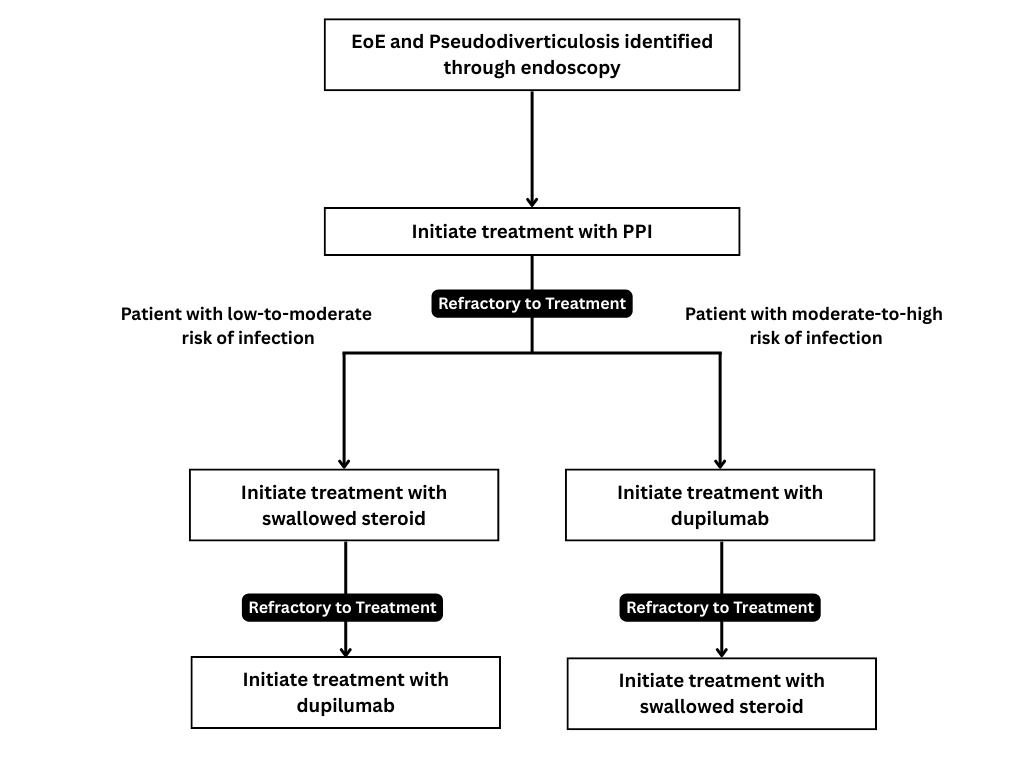Tuesday Poster Session
Category: Esophagus
P4967 - Concurrent Eosinophilic Esophagitis With Esophageal Pseudodiverticulosis: A Treatment Dilemma of Two Rare Pathologies
Tuesday, October 28, 2025
10:30 AM - 4:00 PM PDT
Location: Exhibit Hall
- HN
Hao The Nguyen
Rocky Vista University
waldorf, MD
Presenting Author(s)
Hao The Nguyen, 1, Tudor Oroian, MD2
1Rocky Vista University, Colorado Springs, CO; 2Evans Army Community Hospital, Colorado Springs, CO
Introduction: Esophageal intramural pseudodiverticulosis (EIPD) is characterized by the presence of multiple small outpouchings that protrude from the esophageal lumen, resembling diverticulosis. Eosinophilic esophagitis (EoE) involves eosinophilic infiltration of the esophagus, leading to eventual dysphagia. Both are considered uncommon and their concurrent presentation is exceptionally rare. A systematic search (1960–2025) found no prior reports of EIPD with concurrent EoE and perforation. To our knowledge, we present the first reported case of this rare presentation.
Case Description/
Methods: A 31 year old male presented to the ED with complaints of upper abdominal pain after swallowing a pill without fluids, feeling like it was stuck. Attempts to flush the pill led to multiple bouts of non-bloody emesis. A CT esophagram revealed contrast in the lateral wall of the distal esophagus with pneumomediastinum. Perforation was managed with pain control, antibiotics, and NPO diet that was slowly progressed. He was discharged on 20mg of omeprazole twice daily 4 days later.
He returned 5 months later for chronic dysphagia, refractory to his PPI. EGD revealed numerous small outpouchings, the largest measuring approximately 2mm in diameter. Biopsies were taken from the distal, mid, and proximal esophagus. Esophageal dilation was deferred until definitive diagnosis of underlying condition was established, as well as the risk of perforation. The pathology report revealed over 40 eosinophils per high power field in each region biopsied, confirming diagnosis of EoE. Post-procedure, the patient was placed on 440mcg of swallowed steroids twice daily in addition to his PPI.
Discussion: This case highlights a rare concurrence of two uncommon esophageal conditions, EIPD and EoE, complicated by esophageal perforation. While approximately 320 cases of EIPD have been reported, a small case series (Addasi, 2021) noted only two instances of coexisting EoE with mucosal tears, and none with reported perforation. Some reports describe successful dilation for EIPD, but none in the context of recent perforation. Management is further complicated by overlapping risks: both swallowed steroids (used in EoE) and EIPD are linked to increased oral candidiasis. Dual pathology presents a therapeutic dilemma requiring individualized risk assessment and tolerance. We present a proposed treatment algorithm as a framework for management.

Figure: Pseudodiverticula found on endoscopic exam

Figure: Our proposed treatment algorithm for patients with concurrent EoE and EIPD.
Disclosures:
Hao The Nguyen indicated no relevant financial relationships.
Tudor Oroian indicated no relevant financial relationships.
Hao The Nguyen, 1, Tudor Oroian, MD2. P4967 - Concurrent Eosinophilic Esophagitis With Esophageal Pseudodiverticulosis: A Treatment Dilemma of Two Rare Pathologies, ACG 2025 Annual Scientific Meeting Abstracts. Phoenix, AZ: American College of Gastroenterology.
1Rocky Vista University, Colorado Springs, CO; 2Evans Army Community Hospital, Colorado Springs, CO
Introduction: Esophageal intramural pseudodiverticulosis (EIPD) is characterized by the presence of multiple small outpouchings that protrude from the esophageal lumen, resembling diverticulosis. Eosinophilic esophagitis (EoE) involves eosinophilic infiltration of the esophagus, leading to eventual dysphagia. Both are considered uncommon and their concurrent presentation is exceptionally rare. A systematic search (1960–2025) found no prior reports of EIPD with concurrent EoE and perforation. To our knowledge, we present the first reported case of this rare presentation.
Case Description/
Methods: A 31 year old male presented to the ED with complaints of upper abdominal pain after swallowing a pill without fluids, feeling like it was stuck. Attempts to flush the pill led to multiple bouts of non-bloody emesis. A CT esophagram revealed contrast in the lateral wall of the distal esophagus with pneumomediastinum. Perforation was managed with pain control, antibiotics, and NPO diet that was slowly progressed. He was discharged on 20mg of omeprazole twice daily 4 days later.
He returned 5 months later for chronic dysphagia, refractory to his PPI. EGD revealed numerous small outpouchings, the largest measuring approximately 2mm in diameter. Biopsies were taken from the distal, mid, and proximal esophagus. Esophageal dilation was deferred until definitive diagnosis of underlying condition was established, as well as the risk of perforation. The pathology report revealed over 40 eosinophils per high power field in each region biopsied, confirming diagnosis of EoE. Post-procedure, the patient was placed on 440mcg of swallowed steroids twice daily in addition to his PPI.
Discussion: This case highlights a rare concurrence of two uncommon esophageal conditions, EIPD and EoE, complicated by esophageal perforation. While approximately 320 cases of EIPD have been reported, a small case series (Addasi, 2021) noted only two instances of coexisting EoE with mucosal tears, and none with reported perforation. Some reports describe successful dilation for EIPD, but none in the context of recent perforation. Management is further complicated by overlapping risks: both swallowed steroids (used in EoE) and EIPD are linked to increased oral candidiasis. Dual pathology presents a therapeutic dilemma requiring individualized risk assessment and tolerance. We present a proposed treatment algorithm as a framework for management.

Figure: Pseudodiverticula found on endoscopic exam

Figure: Our proposed treatment algorithm for patients with concurrent EoE and EIPD.
Disclosures:
Hao The Nguyen indicated no relevant financial relationships.
Tudor Oroian indicated no relevant financial relationships.
Hao The Nguyen, 1, Tudor Oroian, MD2. P4967 - Concurrent Eosinophilic Esophagitis With Esophageal Pseudodiverticulosis: A Treatment Dilemma of Two Rare Pathologies, ACG 2025 Annual Scientific Meeting Abstracts. Phoenix, AZ: American College of Gastroenterology.
